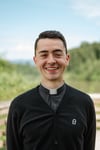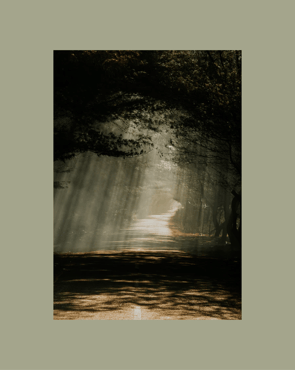Holiness Is Now
You and I are called, by virtue of our baptism, to lead a life of holiness and become a saint— there is no alternative. Feels like a lot to live up to, doesn’t it? A little like an ultimatum. It can sound like God has too high expectations of us. It can bring us to two kinds of conclusions:
Maybe holiness makes you think of those cheap, saccharine holy cards with their depictions of sickly, miserable young men and women.
Or maybe a picture of the towering icons of our recent history: St. John Paul II, St. Theresa of Calcutta, St. Maximillian Kolbe, and Padre Pio, to name a few. The former reaction fails to inspire or impress us, while the latter seems too impressive, and therefore impossible. It’s no wonder most of us file the call to become a saint in the same cabinet as “well-intentioned but unrealistic” or just, “not for me.”
While we all agree that the lifelong journey of holiness amounts to a great and heroic undertaking, most of life simply isn’t made up of many great or heroic moments. If God is indeed calling us to all be saints, where are these great moments for sanctity to be found? Do I have to go serve countries across the world or give my life to a seminary in order to find these moments?
I heard the term, “Holiness is now”. It means that striving for holiness right now, we are given, only by grace, the only opportunity to be called to something that is entirely impossible. And because we trust that God will provide the grace for what He calls us to, we begin to see that through Him, it is no longer impossible.
This became even more real for me when I experienced a glimpse of it.
It was 2014, and two friends and I had just completed our Bachelor’s degree. We immediately agreed that the only way to celebrate this milestone would be with some audacious, multi-month undertaking. Some great or heroic-sounding achievement. We went through the usual post-secondary proposals: backpacking in Southeast Asia? Hosteling across Europe? Hiking the Andes, perhaps? In the midst of this back-and-forth adventure planning, one friend proposed something utterly unexpected: a religious pilgrimage, specifically the Camino de Santiago.

The Camino is an ancient pilgrimage across Spain that begins at the French border and concludes at the other end of Spain, 800km later, at the tomb of the Apostle St. James. The journey, typically a month-and-a-half long, comprises of a constant daily routine of hiking the given route alone or with others, meeting all manner of people along the way, and resting each evening in one of the many modest hostels scattered along the route. Physical fitness and mental resilience are inevitable prerequisites, while blisters, sunburn, and momentary bouts of “why did I sign up for this?” are inevitable daily occurrences.
We were set to begin our pilgrimage in a few short months. My friends and I agreed our immediate task in preparation was a rigorous physical training plan. Our first session consisted of loading our rucksacks with stones and hiking around the North Shore. We lasted an hour or two before the torrential rain, sore feet, and promise of a hot shower at home defeated us. Training Day 1 was largely a failure, but we knew we’d simply come back harder in a few days. Training Day 2, however, quickly devolved into relaxing on the beach while cooking hotdogs over a bonfire. Our third session, and every session after that, never even occurred due to conflicting schedules: I worked a full-time job in a warehouse while balancing ongoing family and Church commitments. The same was true of my friends.
So it was that a few months later we arrived in France, eager to begin the Camino, with all the right gear but certainly less prepared physically than recommended. The evening before we officially began the pilgrimage, we studied the route map in nervous silence, asking ourselves, “have I signed up for more than I can handle? Will I have to call it quits in a few days?”

Our first day on the Camino de Santiago was a ‘wake-up call’ through forested mountains, crumbled cliff-side paths, and sparse water—yet we weren’t completely drained. Nor were we fatigued on the second, third, or fourteenth day. What had happened?
We had set out with heroic intentions to prepare ourselves physically for the Camino, yet we had entirely overlooked the value of the ‘training’ available to us in our daily, ordinary lives: We walked to the bus and our classes, I had a physical job in a warehouse, one friend played hockey after work regularly, and the other was on her feet all day as a nurse. We were seeking heroic moments to get fit when everything we needed had always been available in our daily routine. After 35 days, we joyfully arrived in Santiago. The great and heroic feat of completing this pilgrimage was the final result of remarkably ordinary and simple days.
Holiness is in the everyday. Getting out of bed when the alarm goes off, showing up to work, changing diapers, picking up groceries, answering that phonecall—these are all opportunities for daily holiness in small ways that slowly mould our hearts into deeper holiness.
We wait for moments of great heroism, moments when we can prove our ‘spiritual fitness’ to ourselves, while the ordinary graces necessary for holiness are found in the daily routine of life. Holiness is happening to you right now.
Yes, absolute holiness is impossible. But God has called us to something, impossible as it may seem, and He is providing us with the grace for that call through the present moment.
Just as remarkably ordinary days spent walking amount to the extraordinary feat of completing the Camino, our ability to live each ordinary day in cooperation with the ordinary graces made available to us by God will amount to the most extraordinary feat of all: a life of heroic sanctity. Yes, you and I are called to be saints, and sanctity begins now, because God’s grace is found now.
Enjoy the read? Here is what we recommend.


